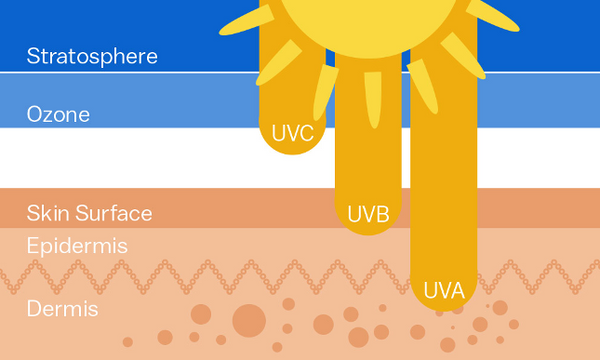Sunscreen: Why Should You Choose Broad-Spectrum Protection?
by darmawanclaudia christin on Aug 03, 2022
We might have known that the sun can be a good source of endorphins, it lifts our mood and makes us happy (and energized). However, prolonged exposure may have some bad side effects on our skin. Just like the old saying, there are always two sides to a story. Then, what can we do to get the best out of the sun? To celebrate the launch of By Wishtrend, UV Defense Moist Cream, we want to remind you how to live, and enjoy your life under the same sun (while keeping your skin safe).
Under the Same Sun, Together and Separate
Don’t forget to join the #UnderTheSameSun challenge by taking a photo or video of you enjoying your moment, lifestyle under the sun. There will be a total of 100 winners receiving the UV Defense Moist Cream! You can find the filter under on @wishtrendtv filter tab and tag us @WishtrendTV @ByWishtrend with our hashtag #UnderTheSameSun.
Applying sunscreen daily has been a day-to-day lifestyle for most people. What makes a good sunscreen? A sunscreen formulated with an SPF of 30 (or above), broad spectrum protection, and the one that you want to apply every single day.
Why does it have to be “broad spectrum”?
We have to learn more about the basics of sunscreen to answer this question. Sunlight is made of multiple wavelengths of light.
1) Ultraviolet radiation (UV) 2) Visible light (VL) 3) Infrared (R)

First, there are three types of UV rays: UVA, UVB, and UVC. The most damaging of all to human skin are UVA and UVB.
1) UVA has the longest wavelength (around 380 - 315 nm) and can penetrate deeper into the dermis layer. It penetrates through the ozone, cloud, and even glass!
2) UVB has a medium wavelength (around 315 - 280 nm) and can penetrated the epidermis layer. It is the type of UV rays that cause redness and sunbrun.
3) UVC has the shortest wavelength and most damaging type of UV Radiation, but the earth's atmosphere helps to filter these UV rays out.

Other than UV rays, there are a few other light sources that can cause long-term skin issues (skin aging, hyperpigmentation, and more):
► Bluelight: A high-energy visible light with a wavelength ranging between 390 – 500nm that penetrates to the deeper layer of the skin. It has been shown that long-term exposure to Bluelight may cause oxidative stress and also hyperpigmentation
► Infrared: Over 40 percent of the sun’s rays that reach the earth, are in the form of infrared (heat). It increases the production of melanocytes and pigment within the skin (worsen melasma) and other inflammatory skin concerns.

Since there are different types of UV rays and other light sources, we need to look for a sunscreen that covers all that. Broad spectrum sunscreen is a sunscreen that helps us to fight against UVA and UVB through SPF (Sun Protection Factor, protects your skin from UVB), and PA (Protection Grade UVA protects the skin from UVA). These two features in broad-spectrum sunscreen work to optimize the protection of our sunscreen. More than ever, now we need wider protection which includes blue light as well as infrared!
Why we should still wear sunscreen indoors?
The most damaging UV rays, namely UVA, can penetrate through your window. If you are doing indoor activities, but are exposed to indirect sunlight through the window, there’s no doubt that the UVA will penetrate your dermis layer and cause photoaging. There’s no guarantee that the UVA won’t affect you since you are not in an outdoor space.
Recently, By Wishtrend just launched their first sunscreen product, and the good news is they provide broad spectrum protection so that you can get the best of your sunny day moment under the sun without worrying about your skin. Let’s see how it can provide that broad spectrum protection!
By Wishtrend UV Defense Moist Cream

INCI list: Aqua (Water), Homosalate, Butylene Glycol, Diethylamino Hydroxybenzoyl Hexyl Benzoate, Ethylhexyl Salicylate, Glycerin, Phenyl Trimethicone, C12-15 Alkyl Benzoate, Silica, Bis-Ethylhexyloxyphenol Methoxyphenyl Triazine, Dibutyl Adipate, Cetearyl Alcohol, Terephthalylidene Dicamphor Sulfonic Acid, 1,2-Hexanediol, Behenyl Alcohol, Tromethamine, Panthenol, Potassium Cetyl Phosphate, Glyceryl Stearate, Polyacrylate Crosspolymer-6, Acrylates/C10-30 Alkyl Acrylate Crosspolymer, Chamomilla Recutita (Matricaria) Flower Water, Hydrogenated Lecithin, Glyceryl Caprylate, C12-15 Alcohols, Stearic Acid, Polyglyceryl-3 Methylglucose Distearate, Palmitic Acid, Disodium EDTA, Ethylhexylglycerin, Adenosine, Glycyrrhiza Glabra (Licorice) Root Extract, Phytosterols, T-Butyl Alcohol, Scutellaria Baicalensis Root Extract, Myristic Acid, Lauric Acid, Camellia Sinensis Leaf Extract, Tocopherol
This sunscreen has an SPF of 50+ PA++++, it has quadruple defense (UVA, UVB, blue light, and infrared) with the soft-hydrating seamless finish!
How it protects from the harmful UV rays:

This sunscreen has also been shown to protect blue light and infrared! It’s a great sunscreen that will keep you safe and happy under the sun.
On top of that, it is also enriched with panthenol which soothes and moisturizes the skin. This allows you to skip your moisturizer in the morning. Apply them early in the morning each day and enjoy the sun anytime, anywhere!












